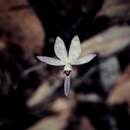en
names in breadcrumbs


Caladenia caerulea, commonly known as the eastern tiny blue china orchid,[2] blue caladenia or blue fairy[3] is a plant in the orchid family Orchidaceae and is endemic to eastern Australia. It has a single narrow leaf and a single blue flower.
Caladenia caerulea is a terrestrial, perennial, deciduous, herb with an underground tuber and a single, sparsely hairy leaf, 20–70 mm (0.8–3 in) long, 2–5 mm (0.08–0.2 in) wide and which usually lies flat on the ground. A single pale to dark blue, rarely white flower 20–30 mm (0.8–1 in) long and wide is borne on a stalk 50–150 mm (2–6 in) tall. The dorsal sepal is erect, 12–16 mm (0.5–0.6 in) long and about 2 mm (0.08 in) wide. The lateral sepals and petals are 12–16 mm (0.5–0.6 in) long, 3–5 mm (0.1–0.2 in) wide and spread like the fingers of a hand. The labellum is 7–9 mm (0.3–0.4 in) long, 6–8 mm (0.2–0.3 in) wide and blue with dark blue bars. The sides of the labellum curve upwards and the small tip turns downwards. There are two rows of yellow-tipped calli along the mid-line of the labellum. Flowering occurs from July to September.[2][3][4]
Caladenia caerulea was first formally described in 1810 by Robert Brown and the description was published in Prodromus florae Novae Hollandiae.[1][5] In 2000, Stephen Hopper and Andrew Brown changed the name to Cyanicula caerulea,[6] but in 2015, as a result of studies of molecular phylogenetics, the name was changed back to Caladenia caerulea.[7] The specific epithet (caerulea) is a Latin word meaning "sky-blue".[8]
In Victoria, C. caerulea is mostly found in central areas growing in stony soil on rocky ridges but it also occurs in coastal heath in the east of the state. In New South Wales and the A.C.T. it grows in woodland and shrub on rocky ridges, mostly in the eastern half of the state. It also occurs in the south-east of Queensland.[2][3][4][9][10]
Caladenia caerulea, commonly known as the eastern tiny blue china orchid, blue caladenia or blue fairy is a plant in the orchid family Orchidaceae and is endemic to eastern Australia. It has a single narrow leaf and a single blue flower.
Cyanicula caerulea é uma espécie de orquídeas geófitas, família Orchidaceae, do sudeste de Queenland até o noroeste da Tasmânia, na Austrália,[1] onde habitam ambientes diversos, sempre com clima marcadamente sazonal. São plantas anuais que crescem solitárias ou em grupos pequenos durante o outono e inverno e florescem no fim do inverno. Sua floração é estimulada por incêndios ocasionais de verão. De cultivo difícil,[2] são compostas por tubérculos completamente recobertos por uma túnica fibrosa, sem raízes, de caules curtos, eretos, não ramificados, com uma única folha membranácea plana basal, ovalada, recoberta por pilosidades, inflorescência terminal,[3] com somente até quatro flores ressupinadas azuladas ou brancas, de segmentos livres e bastante similares. O labelo é muito menor que os outros segmentos, simples ou trilobado, com calos alinhados pelo menos até a metade do disco, preso à coluna por uma garra basal, inteiramente recoberto por pequenas glândulas, normalmente as mais próximas à base, de formato diferente. A coluna é curva e delicada, apoda, com antera terminal e quatro polínias. O nome do gênero nome vem do grego cyano, azul, em alusão à cor das flores da maioria das espécies. Até 2000 este gênero era considerado uma seção de Caladenia.[4]
Sinônimos homotípicos:
Subespécies:
Sinônimos homotípicos:
Cyanicula caerulea é uma espécie de orquídeas geófitas, família Orchidaceae, do sudeste de Queenland até o noroeste da Tasmânia, na Austrália, onde habitam ambientes diversos, sempre com clima marcadamente sazonal. São plantas anuais que crescem solitárias ou em grupos pequenos durante o outono e inverno e florescem no fim do inverno. Sua floração é estimulada por incêndios ocasionais de verão. De cultivo difícil, são compostas por tubérculos completamente recobertos por uma túnica fibrosa, sem raízes, de caules curtos, eretos, não ramificados, com uma única folha membranácea plana basal, ovalada, recoberta por pilosidades, inflorescência terminal, com somente até quatro flores ressupinadas azuladas ou brancas, de segmentos livres e bastante similares. O labelo é muito menor que os outros segmentos, simples ou trilobado, com calos alinhados pelo menos até a metade do disco, preso à coluna por uma garra basal, inteiramente recoberto por pequenas glândulas, normalmente as mais próximas à base, de formato diferente. A coluna é curva e delicada, apoda, com antera terminal e quatro polínias. O nome do gênero nome vem do grego cyano, azul, em alusão à cor das flores da maioria das espécies. Até 2000 este gênero era considerado uma seção de Caladenia.
Cyanicula caerulea là một loài thực vật có hoa trong họ Lan. Loài này được (R.Br.) Hopper & A.P.Br. mô tả khoa học đầu tiên năm 2000.[1]
Cyanicula caerulea là một loài thực vật có hoa trong họ Lan. Loài này được (R.Br.) Hopper & A.P.Br. mô tả khoa học đầu tiên năm 2000.